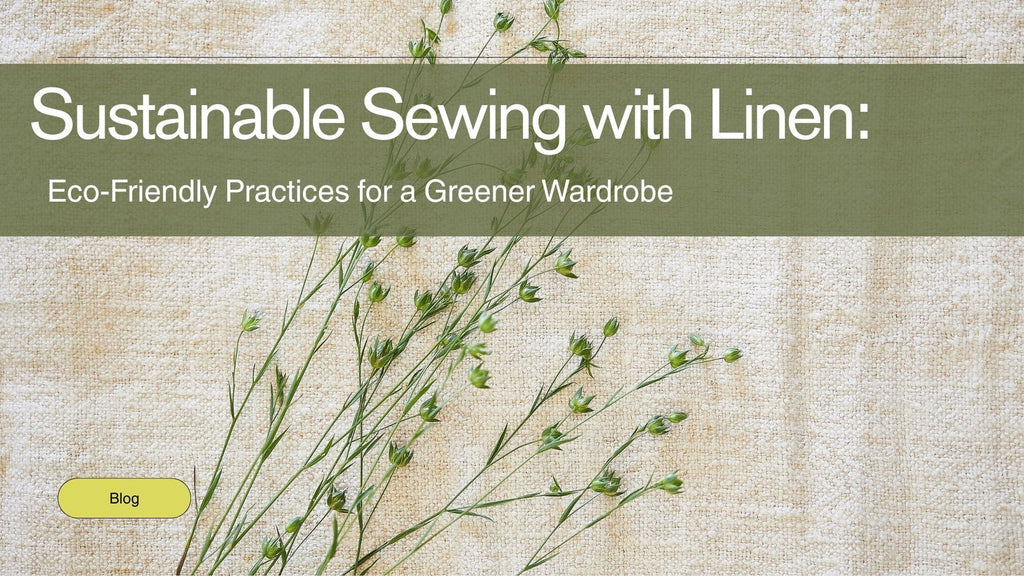Sustainable Sewing: Eco-Friendly Practices for Working with Linen Fabrics

With new trends emerging every day in the fashion industry, the rapid production and disposal of cheap clothing can create a devastating impact on the planet. As companies rush to increase their production through unsustainable routes, significant amounts of pollution and excessive waste production turn into unmanageable crises.
But all is not lost; embracing linen presents a more sustainable way to eliminate fast fashion's effects on the environment. That’s because linen presents many benefits for sustainability compared to other textiles.
Eco-conscious benefits of linen in clothing production

Linen fabric is widely accepted and revered for its durability, natural elegance, and breathability. But most importantly, it has properties that make it a sustainable choice of textile in the clothing industry. These include:
Biodegradability and renewability
Linen is the end product of the processing of flax plant cellulose fibre. It’s processed without chemical additives, while flax doesn’t need much herbicide or water during its cultivation. Unlike polyester and other synthetic fibres, linen is biodegradable. This reduces the impact on the environment and helps avoid the accumulation of landfill waste.
Low environmental footprint

Compared to other textiles, flax cultivation has a relatively low impact on the environment. Flax is resilient in adverse climates and doesn’t need extensive use of chemicals. This makes linen production eco-friendly.
Crude oil unrelated
One of the common fabrics in the fast fashion industry is polyester, which is plastic-based. This means it needs high amounts of energy and crude oil processing to produce it. On the contrary, linen is purely plant-based and doesn’t require crude oil or other chemicals, making it a more sustainable fabric.
High durability
Linen is known to provide durability greater than that of cotton. which makes any linen garment extra long-lasting. With more durable clothing, the pressure exerted on resources needed for production is reduced because the frequency of replacement is also lower.
Sustainable linen sewing practices to reduce wastage
Linen is an excellent fabric with eco-friendly properties that make it a sustainable choice for clothing production. In addition to this, we need to adopt sustainable sewing practices and work towards a greener planet.
Whether you're a seamstress at your beginner level or an expert, you can adopt these linen sewing practices to help minimise waste and lead the way to a more sustainable environment.
Choose high-quality, sustainable fabric.
Sewing is a form of art, just like sculpting. Fabric is to a sewer as marble is to a sculptor. Without it, there’s no art. When choosing your tools of trade, always go for high-quality types. Instead of cheap fabric like polyester, go for linen or other sustainable options like hemp, Tencel, organic cotton, or recycled fabric.
Repair your garments
Every time clothes are torn around the seam or hem, most people rush to replace them with new ones. Instead of this, repairing is a more sustainable option, as it helps reduce replacement frequency. Sew your clothes with a wider hem and seam allowances to protect them against tearing.
Embrace deadstock fabric

When fabric stock goes unsold, it’s eventually discarded, instead of going for brand-new fabric, shop for dead stock to reduce waste that could potentially impact the environment.
Zero-Waste Sewing Patterns

When cutting your fabric, optimise your cuts with zero-waste sewing patterns. These are fabric-cutting styles meant to minimise waste when sewing by utilising innovative techniques and design elements. Instead of printed pattern pieces, you draw the patterns directly on the fabric while maximising usage to reduce waste.
Fabric scraps for small projects

You don’t need to go fabric shopping when doing a small sewing project. Reuse the scrap pieces from your past projects as patch pockets, decorative appliques, or fabric buttons. Go beyond your way to add some creativity to scrap-busting projects and make the best use of leftover linen fabric.
Mindfulness when sewing

When sewing, mistakes can happen, and some can lead to ruining an entire piece of fabric. Just be a little more mindful when working on your linen projects to reduce errors and minimise fabric waste. Read your measurements accurately and plan your projects thoughtfully to avoid ripping seams unnecessarily.
Summary
As the world grapples with the effects of unsustainable practices in the fast fashion industry, it’s up to every sewist to help bring back sanity in the industry. Embrace more eco-friendly fabrics, particularly linen, known for its durability, biodegradability, and low environmental footprint. Most importantly, apply sustainable sewing practices to minimise waste.


